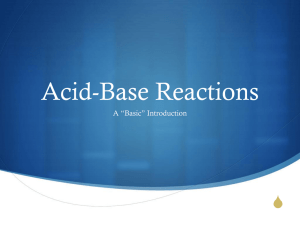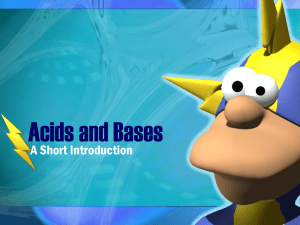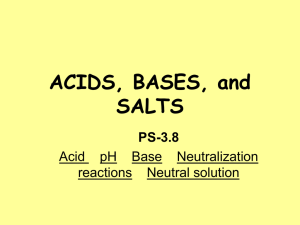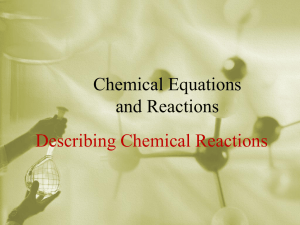Writing Net Ionic Equations
advertisement
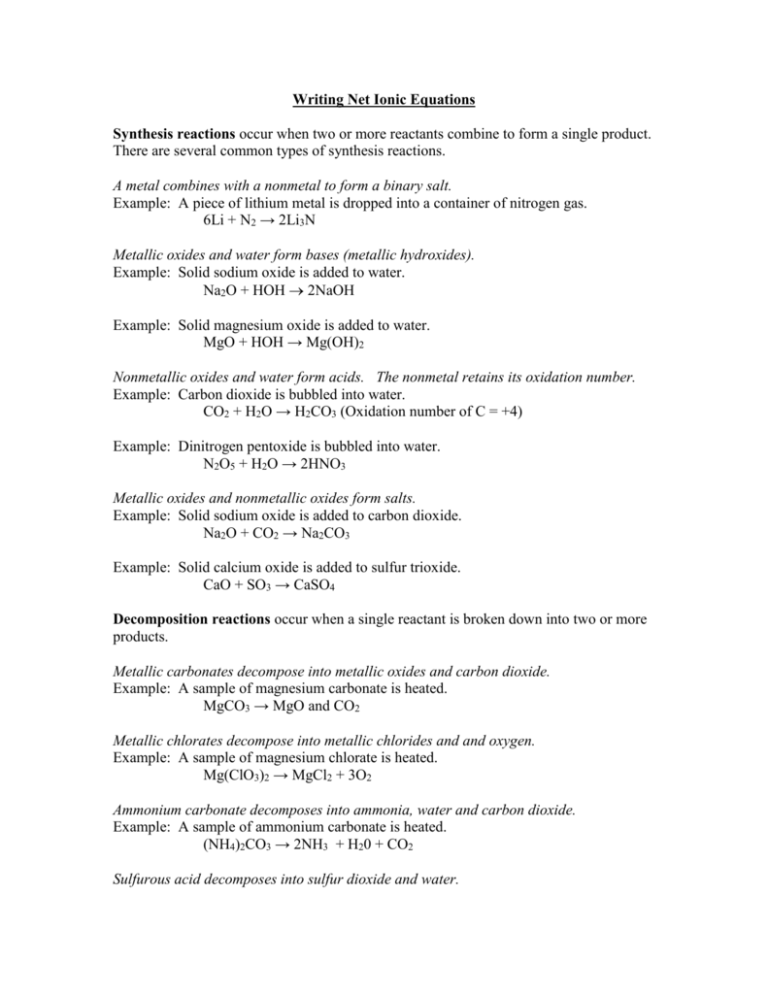
Writing Net Ionic Equations Synthesis reactions occur when two or more reactants combine to form a single product. There are several common types of synthesis reactions. A metal combines with a nonmetal to form a binary salt. Example: A piece of lithium metal is dropped into a container of nitrogen gas. 6Li + N2 → 2Li3N Metallic oxides and water form bases (metallic hydroxides). Example: Solid sodium oxide is added to water. Na2O + HOH 2NaOH Example: Solid magnesium oxide is added to water. MgO + HOH → Mg(OH)2 Nonmetallic oxides and water form acids. The nonmetal retains its oxidation number. Example: Carbon dioxide is bubbled into water. CO2 + H2O → H2CO3 (Oxidation number of C = +4) Example: Dinitrogen pentoxide is bubbled into water. N2O5 + H2O → 2HNO3 Metallic oxides and nonmetallic oxides form salts. Example: Solid sodium oxide is added to carbon dioxide. Na2O + CO2 → Na2CO3 Example: Solid calcium oxide is added to sulfur trioxide. CaO + SO3 → CaSO4 Decomposition reactions occur when a single reactant is broken down into two or more products. Metallic carbonates decompose into metallic oxides and carbon dioxide. Example: A sample of magnesium carbonate is heated. MgCO3 → MgO and CO2 Metallic chlorates decompose into metallic chlorides and and oxygen. Example: A sample of magnesium chlorate is heated. Mg(ClO3)2 → MgCl2 + 3O2 Ammonium carbonate decomposes into ammonia, water and carbon dioxide. Example: A sample of ammonium carbonate is heated. (NH4)2CO3 → 2NH3 + H20 + CO2 Sulfurous acid decomposes into sulfur dioxide and water. Example: A sample of sulfurous acid is heated. H2SO3 → H2O + SO2 Carbonic acid decomposes into carbon dioxide and water. Example: A sample of carbonic acid is heated. H2CO3 → H2O + CO2 Ammonium hydroxide decomposes into ammonia and water. Example: A sample of ammonium hydroxide is heated. NH4OH NH3 + H2O Hydrogen peroxide decomposes into water and oxygen. Example: A sample of hydrogen peroxide is heated. 2H2O2 2H2O + O2 A binary compound may break down into two elements. Example: Molten sodium chloride is electrolyzed. 2NaCl 2Na + Cl2 Single replacement reactions are reactions that involve an element replacing one part of a compound. The products include the displaced element and a new compound. An element can only replace another element that is less active than itself. General activity series for metals: (Most active) Li Ca Na Mg Al Zn Fe Pb [H2] Cu Ag Pt (Least active) General activity series for nonmetals: (Most active) F2 Cl2 Br2 I2 (least active) Here are some common types of single replacement reactions. Active metals replace less active metals from their compounds in aqueous solution. Example: Magnesium turnings are added to a solution of iron (III) chloride. 3Mg + 2FeCl3 2 Fe + 3MgCl2 Active metals replace hydrogen in water. Example: Sodium is added to water. 2Na + 2HOH H2 + 2NaOH Active metals replace hydrogen in acids. Example: Lithium is added to hydrochloric acid. 2Li + 2HCl H2 + 2LiCl Active nonmetals replace less active nonmetals from their compounds in aqueous solution. Example: Chlorine gas is bubbled into a solution of potassium iodide. Cl2 + 2KI I2 + 2KCl If a less reactive metal is combined with a more reactive element in compound form, there will be no resulting reaction. Example: Chlorine gas is bubbled into a solution of potassium fluoride. Cl2 + KF no reaction Example: Zinc is added to a solution of sodium chloride. Zn + NaCl no reaction NOTE: On the AP reaction prediction section, all reactions “work”; in other words, there will be no “no reaction” problems on the AP exam. Double Replacement (Metathesis) Reactions In many reactions between two compounds in aqueous solution, the cations and anions appear to switch partners according to the following equation: AX + BY → AY + BX The two compounds react to form two new compounds. No changes in oxidation numbers occur. Reactions of this type are known as double replacement or metathesis reactions. An example of such a reaction would be the mixing of aqueous solutions of potassium bromide and silver nitrate forming insoluble silver bromide (precipitate) and aqueous potassium nitrate; KBr (aq) + AgNO3 (aq) → AgBr (s) + KNO3 (aq) Note that each cation pairs up with the anion in the other compound, thus switching partners. Anions do not pair up with anions and cations do not pair up with cations. Likes repel; opposites attract! 1. Formation of a precipitate: A precipitate is an insoluble substance (solid) formed by the reaction of two aqueous substances. It is the result of ions binding together so strongly that the solvent (water) cannot pull them apart. The insoluble solid (or solids if a double precipitate occurs!) will settle out (precipitate) from the solution and this results in the removal of ions from solution. 2. Formation of a gas: Gases may form directly in a double replacement reaction or from the decomposition of one of the products. The gases will bubble off or evolve from the solution. 3. Formation of primarily molecular species: The formation of primarily unionized molecules in solution removes ions from the solution and the reaction “works” or is said to go to completion. Unionized or partially ionized molecules give solutions that are known as nonelectrolytes or weak electrolytes. The best known nonelectrolyte is water formed in acid-base neutralization reactions. Acetic acid is an example of an acid that is primarily molecular (weak electrolyte) when placed in water. Reversible Reactions If a double replacement reaction does not go to completion (no precipitate, gas or molecular species is formed), then the reaction is reversible (no ions have been removed). Reversible reactions are at equilibrium and have both forward and reverse reactions taking place. In a reversible reaction, evaporation of the water solvent will result in solid residues of both reactants and products. The reaction is not driven to completion (products) because no ions have been removed. A double arrow is used to designate a reversible reaction at equilibrium. BaCl2 (aq) + 2 NaNO3 (aq) Ba(NO3)2 (aq) + 2 NaCl (aq) Solubility Rules The solubility classification of ionic substances according to their solubility in water is difficult. Nothing is completely “insoluble” in water. The degree of solubility varies from one “soluble” substance to another. Nevertheless, a solubility classification scheme is useful even though it must be regarded as an approximate guideline. Learn the solubility rules! Formation of a Gas Common gases formed in metathesis reactions are: H2S: Any sulfide (salt of S2-) plus any acid for H2S (g) and a salt. CO2: Any carbonate (salt of CO32-) plus any acid for CO2 (g) , HOH and a salt. SO2: Any sulfite (salt of SO32-) plus any acid form SO2 (g), HOH and a salt. NH3: Any ammonium salt (salt of NH4+) plus any soluble strong hydroxide react upon heating to form NH3 (g), HOH and a salt. Reactions that produce three of the gases (CO2, SO2, and NH3) involve the initial formation of a substance that breaks down to give the gas ad HOH. Example: The reaction of Na2SO3 and HCl produces H2SO3. Na2SO3 (aq) + 2HCl (aq) → H2SO3 (aq) + 2 NaCl (aq) Bubbling is observed in this reaction because the H2SO3 (sulfurous acid) is unstable and immediately decomposes to give HOH and SO2 gas: H2SO3 (aq) → HOH (l) and SO2 (g) The molecular equation for the complete reaction, therefore, is Na2SO3 (aq) + 2HCl (aq) → HOH (l) + SO2 (g) + 2 NaCl (aq) Example: A typical reaction of a carbonate and an acid is: K2CO3 (aq) and 2HNO3 (aq) → HOH (l) + CO2 (g) + 2KNO3 (aq) Bubbling is also observed in this reaction. Theoretically, H2CO3, carbonic acid, is formed, but the acid is unstable and immediately decomposes to form carbon dioxide gas and water according to the following equation: H2CO3 → HOH (l) and CO2 (g) Example: Ammonium salts and soluble bases react as follows (particularly when the solution is warmed): NH4Cl (aq) + NaOH (aq) → NH3 (g) +HOH (l) + NaCl (aq) The odor of ammonia gas is noted and moist red litmus paper held near the mouth of the container will turn blue. Theoretically, NH4OH, ammonium hydroxide, is produced (also known as ammonia water). The compound is unstable and decomposes into ammonia gas and water: NH4OH (aq) → NH3 (g) + HOH (l) Example: The odor of rotten eggs and bubbling are noted when an acid is added to a sulfide. A typical reaction producing hydrogen sulfide gas is: FeS (s) + 2HCl (aq) → FeCl2 (aq) + H2S (g) NOTE: Be aware of reactions involving the formation of carbon dioxide, sulfur dioxide, ammonia and hydrogen sulfide gases on the AP exam. Over the years these reactions have appeared many, many times. Know these four gases and how they are produced! Formation of a Molecular Species (Weak or Nonelectrolytes) Metathesis reactions that produce primarily molecules in the form of partially dissociated or ionized molecules (weak electrolytes) or molecules that do not ionized of dissociated at all (nonelectrolytes) serve as the driving force in some aqueous reactions. Forming molecular products in double replacement reactions results in the removal of ions from solution. Such reactions tend to go to completion (shift to the right) and form primarily products. General rules: 1. The six common strong acids, and thus strong electrolytes, are HClO4, HCl, HBr, HI, HNO3 and H2SO4. (Memorize these!) All other common acids are weak acids and thus weak electrolytes. (HC2H3O2 or CH3COOH, H3PO4, HF and HNO2 are examples of weak acids. Note: All organic acids (R-COOH) are weak electrolytes.) All strong acids in their pure form (as opposed to dilute aqueous form!) are nonelectrolytes (molecular). When water is added, the action of the solvent water with a strong acid produces a hydrated proton (hydronium ion) and a negatively charged anion. The process of making ions from molecular species is known as ionization. Strong acids ionize 100% in water. An example of a strong electrolyte undergoing ionization is as follows: HCl (aq) + H2O (l) → H3O+ (aq) + Cl- (aq) This reaction may be abbreviated as: HCl (aq) → H+ (aq) + Cl- (aq) 2. The common strong bases are the soluble hydroxides (those of Group IA elements and Ba2+) and the slightly soluble hydroxides (those of Ca2+ and Sr2+). Strong bases, like strong acids, are strong electrolyte. (Memorize these!) NH4OH is a soluble weak electrolyte which normally decomposes into NH3 (g) and HOH (l). Technically speaking, the pure compound ammonium hydroxide has never been isolated and the substance is more correctly known as aqueous ammonia. Most other hydroxides are insoluble. Pure liquid hydroxides are strong hydroxides because they already contain ions. The action of the solvent water releasing the ions of a base into solution is known as dissociation. Acids ionize in water; bases dissociate. 3. Most common (soluble) salts are strong electrolytes and thus dissociate inot ions when placed into water. 4. Water is a weak electrolyte which is typically produced in acid-base neutralization reactions. Some examples of weak electrolytes forming as products (shown in bold): Ca(CH3COO)2 (aq) + 2HCl (aq) → CaCl2 (aq) + 2CH3COOH (aq) 2Na3PO4 (aq) + 3H3PO4 (aq) → 3Na2SO4 (aq) + 2H3PO4 (aq) HCl (aq) + NaOH (aq) → NaCl (aq) + HOH (l) Acid-Base Neutralization Reactions Acids react with bases to produce salts and water. One mole of hydrogen ions will react with one mole of hydroxide ions to produce one mole of water. Learn which acids are strong (written in ionic form!) and which acids are weak (written in molecular form)! Check the solubility rules for the solubility of the salt produced! If it is soluble, it is written in ionic form; if it is insoluble it is written in molecular form. Acid + Base → Salt + Water (A salt consists of a cation from a base and an anion from an acid. For example, the salt sodium sulfate contains sodium ions form sodium hydroxide and sulfate ions from sulfuric acid.) Example: Hydrogen sulfide gas is bubbled through excess potassium hydroxide solution. H2S (g) + KOH (aq) → K2S (aq) + 2HOH (l) Polyprotic acids can be tricky when it comes to predicting neutralization reactions. Sulfuric acid and phosphoric acid are classic examples frequently encountered on AP exams. If the base is in excess, all hydrogen ions will react with the strong base to produce water. Example: Dilute sulfuric acid is reacted with excess sodium hydroxide solution. H2SO4 (aq) + 2NaOH (aq) → Na2SO4 (aq) + 2HOH (l) If, however, the reaction above stated that equal numbers of moles of sulfureic acid and sodium hydroxide react, then the coefficients for both reactants must be one and the salt that forms is sodium hydrogen sulfate. Example: Equal number of moles of sulfuric acid and sodium hydroxide solution mix. H2SO4 (aq) + NaOH (aq) → NaHSO4 (aq) + HOH (l) Take into account information dealing with the quantity of each reactant! Example: Equal volumes of 0.1M phosphoric acid and 0.2M sodium hydroxide are mixed together. H3PO4 (aq) + 2NaOH (aq) → Na2PO4 (aq) + 2HOH (l) Watch for substances that react with water before reacting with an acid or a base. The acid and basic anhydrides behave in such a manner. These are really two-step reactions. Example: Excess sulfur dioxide gas is bubbled into a saturated solution of calcium hydroxide. SO2 (g) + Ca(OH)2 (aq) → CaSO3 (s) + HOH (l) (Remember, SO2 (g) is an acid anhydride!) If an acid + base yields a salt + water, then an acid anhydride + basic anhydride will yield a salt. Example: Sulfur dioxide gas and solid calcium oxide are reacted together. SO2 (g) + CaO (s) → CaSO3 (s) (SO2 (g) is the acid anhydride for sulfurous acid; CaO (s) is the basic anhydride for calcium hydroxide.) Aqueous Solutions and Ionic Equations It is now time to concentrate on writing chemical equations in the form required for the AP Chem exam! All equations in the previous sections were written as if the reactants and products were molecular. In overall (total) ionic equations, formulas of the reactants and products are written to show the predominant form of each substance as it exists in aqueous solution. Soluble salts, strong acids and strong bases are written as separated ions. Insoluble salts, suspensions, solids, weak acids, weak gases, gases, water and organic compounds are always written as individual molecules. Consider the following molecular equation: Cd(NO3)2 (aq) + Na2S (aq) → CdS (s) + 2NaNO3 (aq) The overall ionic equation for this reaction is Cd2+ (aq) + 2NO3- (aq) + 2Na+ (aq) + S2- (aq) → CdS (s) + 2Na+(aq) + 2NO3- (aq) Note that this equation illustrates that cadmium nitrate dissociates into three ions (one cadmium ion and two nitrate ions); sodium sulfide dissociates into two sodium ions and one sulfide ion; the soluble sodium nitrate formed remains dissociated as two sodium and two nitrate ions. The precipitated (insoluble) cadmium is undissociated. Also note that the parentheses that appear in a molecular formula are not used when representing the ionic form in solution. For example, dissociated cadmium nitrate contains no parentheses. Note: The only common substances that should be written as ions in ionic equations are soluble salts, strong acids and strong bases. Net ionic equations are written to show only the species that react or undergo change in aqueous solution. The net ionic equation is obtained by eliminating the spectator ions form an overall ionic equation. All that is left are the ions that have changed chemically. Spectators at a sporting event watch the action unfolding in front of them rather than participating; spectator ions likewise do not participate in the reaction. The elimination of spectator ions allows us to concentrate only on the reacting species. Molecular equations provide complete chemical formulas which are of necessity when it comes to doing stoichiometric calculations. Overall ionic equations, the intermediated between molecular and net ionic equations, show what is happening to all species in the solution. Such equations are very helpful when dealing with hydrolysis, electrical conductivity, and colligative properties. Net ionic equations are the simplest form of equations and show only the reacting species. Molecular: Cd(NO3)2 (aq) + Na2S (aq) → CdS (s) + 2NaNO3 (aq) Overall Ionic Cd2+ (aq) + 2NO3- (aq) + 2Na+ (aq) + S2- (aq) → CdS (s) + 2Na+(aq) + 2NO3- (aq) (The spectator ions have been highlighted in bold!) Net Ionic Cd2+ (aq) + S2- (aq) → CdS (s) Example: Aqueous solutions of sulfuric acid and excess sodium hydroxide are reacted. H2SO4 (aq) + 2NaOH (aq) → 2 HOH (l) + Na2SO4 (aq) H+ + HSO4- + 2Na+ +2OH- → 2HOH (l) + 2Na+ (aq) + SO42- (aq) H+ + HSO4- + 2OH- → 2HOH (l) + SO42- (aq) Special note: The first proton in sulfuric acid is ionized completely; the second proton is only partially ionized. Sulfuric acid is the only polyprotic acid that exhibits this property. All other polyprotic acids are weak and are written in their molecular forms! Example: Aqueous solutions of sulfuric acid and excess sodium hydroxide are combined. H2SO4 (aq) + Ba(OH)2 (aq) → 2 HOH (l) + BaSO4 (s) H+ + HSO4- + Ba2+ +2OH- → 2HOH + BaSO4 H+ + HSO4- + Ba2+ +2OH- → 2HOH + BaSO4 Example: Sodium acetate undergoes hydrolysis when placed in water. NaCH3COO (aq) + HOH (l) → NaOH (aq) + CH3COOH (aq) Na+ + CH3COO- + HOH → Na+ + OH- + CH3COOH CH3COO- + HOH → OH- + CH3COOH Example: Equal volumes of 0.2 M potassium hydroxide and 0.2 M phosphoric acid are reacted. KOH (aq) + H3PO4 (aq) → HOH (l) + KH2PO4 (aq) K+ + OH- + H3PO4 → HOH (l) + K+ + H2PO4OH- + H3PO4 → HOH (l) + H2PO4Example: Aqueous solutions of potassium chromate and silver nitrate are reacted. K2CrO4 (aq) + 2AgNO3 (aq) → 2KNO3 (aq) + Ag2CrO4 (s) 2K+ + CrO42- + 2Ag+ + 2NO3- → 2K+ + 2NO3- + Ag2CrO4 (s) CrO42- + 2Ag+ → Ag2CrO4 (s) Example: Aqueous ammonium sulfide reacts with excess aqueous lithium hydroxide. (NH4)2S (aq) + 2LiOH (aq) → Li2S (aq) + 2NH3 (g) + 2HOH (l) 2NH4- + S- + 2Li+ + OH- → 2Li+ +S2- + 2NH3 (g) + 2HOH (l) 2NH4- + OH- → 2NH3 (g) + 2HOH (l) Example: Excess acetic acid reacts with aqueous ammonium sulfite. 2CH3COOH (aq) + Na2SO3 (aq) → 2NaCH3COO (aq) + HOH (l) + SO2 (g) 2CH3COOH + 2Na+ + SO3- → 2Na+ + 2CH3COO- + HOH + SO2 2CH3COOH + SO3- → 2CH3COO- + HOH + SO2 Example: Calcium carbonate in aqueous suspension reacts with dilute hydrochloric acid. CaCO3 (s) + 2HCl (aq) → CaCl2 (aq) + HOH (l) + CO2 (g) CaCO3 + 2H+ + 2Cl- → Ca2+ +2Cl- + HOH + CO2 CaCO3 + 2H+ → Ca2+ + HOH + CO2




